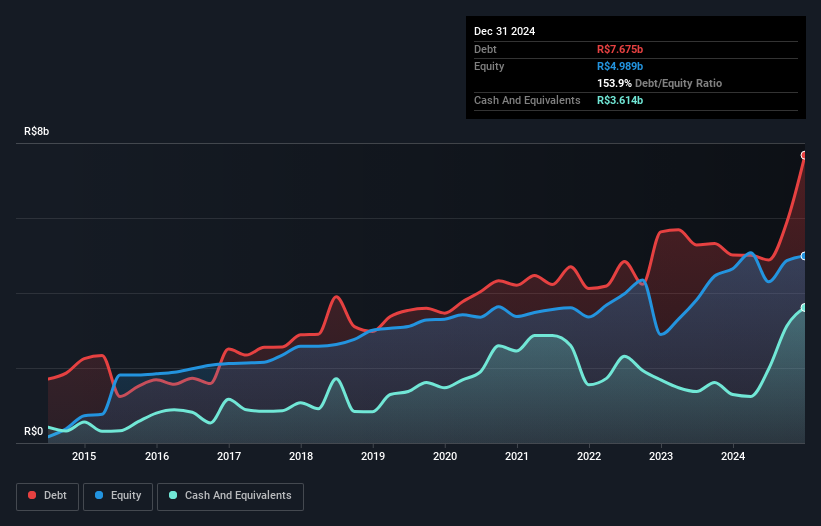- Brazil
- /
- Electric Utilities
- /
- BOVESPA:EQPA3
We Think Equatorial Pará Distribuidora de Energia (BVMF:EQPA3) Is Taking Some Risk With Its Debt
Legendary fund manager Li Lu (who Charlie Munger backed) once said, 'The biggest investment risk is not the volatility of prices, but whether you will suffer a permanent loss of capital.' So it might be obvious that you need to consider debt, when you think about how risky any given stock is, because too much debt can sink a company. We note that Equatorial Pará Distribuidora de Energia S.A. (BVMF:EQPA3) does have debt on its balance sheet. But the real question is whether this debt is making the company risky.
We've discovered 3 warning signs about Equatorial Pará Distribuidora de Energia. View them for free.When Is Debt Dangerous?
Debt and other liabilities become risky for a business when it cannot easily fulfill those obligations, either with free cash flow or by raising capital at an attractive price. Part and parcel of capitalism is the process of 'creative destruction' where failed businesses are mercilessly liquidated by their bankers. However, a more common (but still painful) scenario is that it has to raise new equity capital at a low price, thus permanently diluting shareholders. Of course, plenty of companies use debt to fund growth, without any negative consequences. When we examine debt levels, we first consider both cash and debt levels, together.
How Much Debt Does Equatorial Pará Distribuidora de Energia Carry?
As you can see below, at the end of December 2024, Equatorial Pará Distribuidora de Energia had R$7.68b of debt, up from R$5.01b a year ago. Click the image for more detail. On the flip side, it has R$3.61b in cash leading to net debt of about R$4.06b.

A Look At Equatorial Pará Distribuidora de Energia's Liabilities
Zooming in on the latest balance sheet data, we can see that Equatorial Pará Distribuidora de Energia had liabilities of R$4.40b due within 12 months and liabilities of R$8.44b due beyond that. Offsetting these obligations, it had cash of R$3.61b as well as receivables valued at R$3.15b due within 12 months. So its liabilities outweigh the sum of its cash and (near-term) receivables by R$6.08b.
Equatorial Pará Distribuidora de Energia has a market capitalization of R$13.9b, so it could very likely raise cash to ameliorate its balance sheet, if the need arose. But we definitely want to keep our eyes open to indications that its debt is bringing too much risk.
View our latest analysis for Equatorial Pará Distribuidora de Energia
In order to size up a company's debt relative to its earnings, we calculate its net debt divided by its earnings before interest, tax, depreciation, and amortization (EBITDA) and its earnings before interest and tax (EBIT) divided by its interest expense (its interest cover). The advantage of this approach is that we take into account both the absolute quantum of debt (with net debt to EBITDA) and the actual interest expenses associated with that debt (with its interest cover ratio).
Equatorial Pará Distribuidora de Energia's net debt is only 1.3 times its EBITDA. And its EBIT easily covers its interest expense, being 16.1 times the size. So you could argue it is no more threatened by its debt than an elephant is by a mouse. On the other hand, Equatorial Pará Distribuidora de Energia's EBIT dived 14%, over the last year. We think hat kind of performance, if repeated frequently, could well lead to difficulties for the stock. There's no doubt that we learn most about debt from the balance sheet. But it is Equatorial Pará Distribuidora de Energia's earnings that will influence how the balance sheet holds up in the future. So when considering debt, it's definitely worth looking at the earnings trend. Click here for an interactive snapshot.
Finally, a business needs free cash flow to pay off debt; accounting profits just don't cut it. So it's worth checking how much of that EBIT is backed by free cash flow. Considering the last three years, Equatorial Pará Distribuidora de Energia actually recorded a cash outflow, overall. Debt is far more risky for companies with unreliable free cash flow, so shareholders should be hoping that the past expenditure will produce free cash flow in the future.
Our View
Neither Equatorial Pará Distribuidora de Energia's ability to convert EBIT to free cash flow nor its EBIT growth rate gave us confidence in its ability to take on more debt. But the good news is it seems to be able to cover its interest expense with its EBIT with ease. We should also note that Electric Utilities industry companies like Equatorial Pará Distribuidora de Energia commonly do use debt without problems. Taking the abovementioned factors together we do think Equatorial Pará Distribuidora de Energia's debt poses some risks to the business. So while that leverage does boost returns on equity, we wouldn't really want to see it increase from here. When analysing debt levels, the balance sheet is the obvious place to start. But ultimately, every company can contain risks that exist outside of the balance sheet. For instance, we've identified 3 warning signs for Equatorial Pará Distribuidora de Energia (1 is a bit concerning) you should be aware of.
When all is said and done, sometimes its easier to focus on companies that don't even need debt. Readers can access a list of growth stocks with zero net debt 100% free, right now.
Valuation is complex, but we're here to simplify it.
Discover if Equatorial Pará Distribuidora de Energia might be undervalued or overvalued with our detailed analysis, featuring fair value estimates, potential risks, dividends, insider trades, and its financial condition.
Access Free AnalysisHave feedback on this article? Concerned about the content? Get in touch with us directly. Alternatively, email editorial-team (at) simplywallst.com.
This article by Simply Wall St is general in nature. We provide commentary based on historical data and analyst forecasts only using an unbiased methodology and our articles are not intended to be financial advice. It does not constitute a recommendation to buy or sell any stock, and does not take account of your objectives, or your financial situation. We aim to bring you long-term focused analysis driven by fundamental data. Note that our analysis may not factor in the latest price-sensitive company announcements or qualitative material. Simply Wall St has no position in any stocks mentioned.
About BOVESPA:EQPA3
Equatorial Pará Distribuidora de Energia
Equatorial Pará Distribuidora de Energia S.A.
Fair value second-rate dividend payer.
Market Insights
Weekly Picks

THE KINGDOM OF BROWN GOODS: WHY MGPI IS BEING CRUSHED BY INVENTORY & PRIMED FOR RESURRECTION


Why Vertical Aerospace (NYSE: EVTL) is Worth Possibly Over 13x its Current Price


The Quiet Giant That Became AI’s Power Grid
Recently Updated Narratives


Mastersystem Infotama will achieve 18.9% revenue growth as fair value hits IDR1,650


Insiders Sell, Investors Watch: What’s Going On at PG?

Waiting for the Inevitable
Popular Narratives


MicroVision will explode future revenue by 380.37% with a vision towards success


NVDA: Expanding AI Demand Will Drive Major Data Center Investments Through 2026




